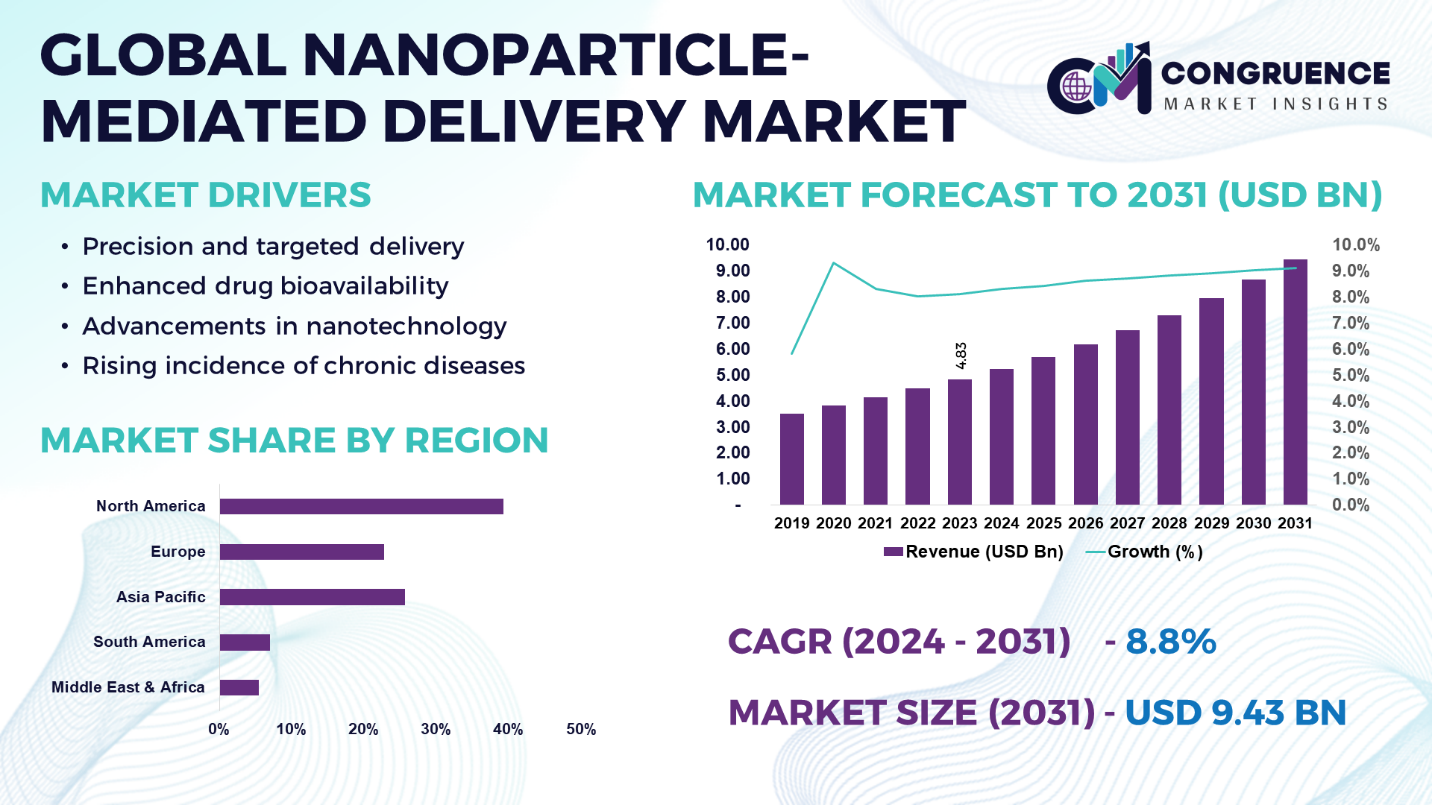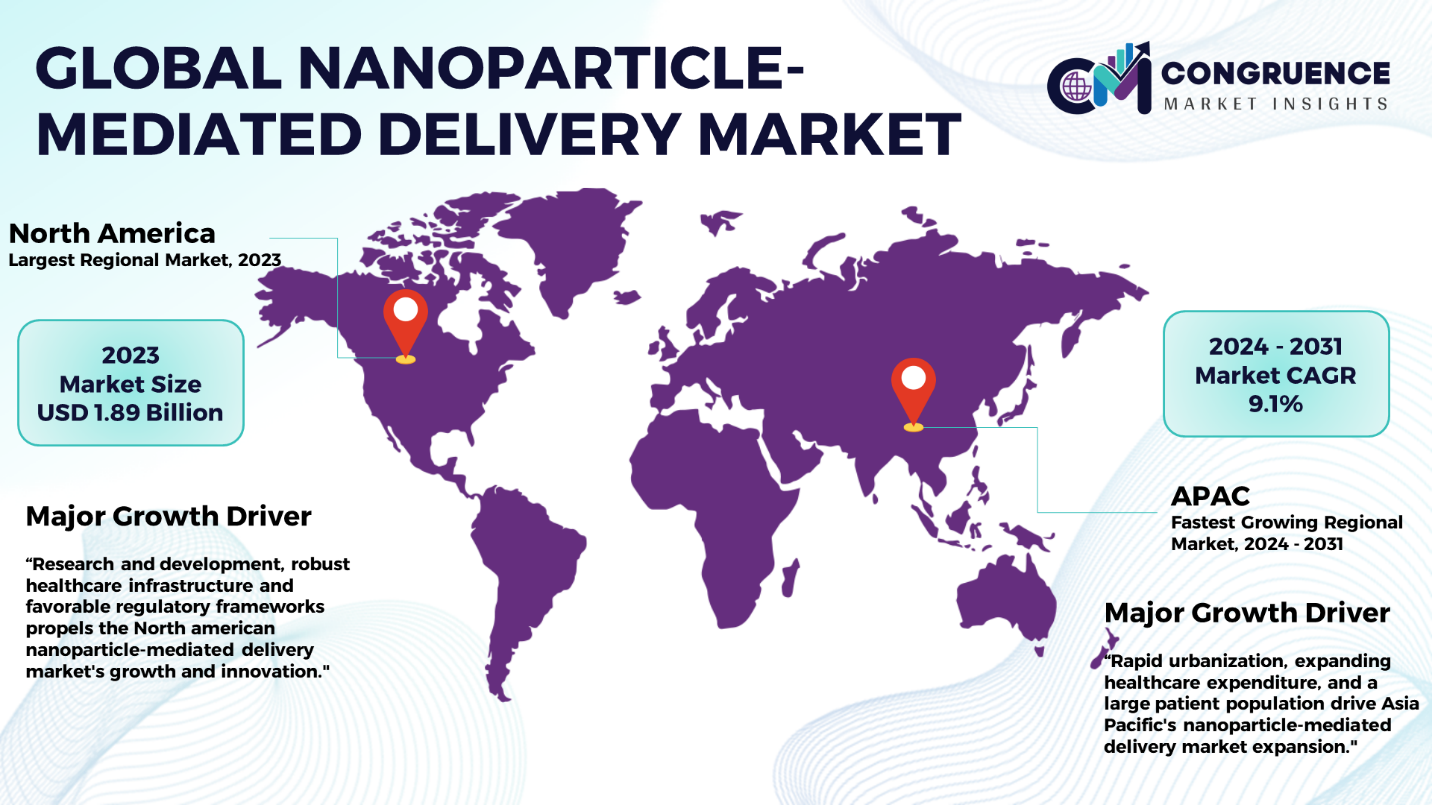Reports
The Global Nanoparticle-Mediated Delivery Market was valued at USD 4.83 Billion in 2023 and is anticipated to reach a value of USD 9.43 Billion by 2031 expanding at a CAGR of 8.8% between 2024 and 2031.
The worldwide nanoparticle delivery sector announces a new era, whereby a paradigm shift in drug delivery techniques is introduced, welcomed through the advent of precision medicine and selective treatments. Taking advantage of the special features possessed by these nanoparticles makes it possible to ship and deliver therapies to designated cells, tissues, or organs within the human body in a controlled and targeted manner. Nanoparticles defined by their size from 1 to 100 nanometers, amaze by several advantages like higher solubility, extended circulation and penetrating the biological barriers. These are crucial for improving drug bioavailability and performance. Such an advanced method puts a stick of dynamite in the very fingertips of therapeutics, offering a crucial alternative to the existing drug delivery methodology, especially in fields such as cancer, neurology, cardiology, and infectious diseases, where the conventional method fails. Through drug, nucleic acid, or imaging agent encapsulation in nanoparticles, a considerable potential toward overcoming drug delivery challenges is crystallized, which otherwise are extremely difficult to cross due to factors such as low drug solubility, excessive toxicity, and limited spatial access to target tissues. Owing to nanotechnology, materials science and biopharmaceuticals that behave as innovation drivers, the world market of nanoparticle-mediated delivery is an indispensable element in the new chain of personalized medicine, disease interception, and better patient health.

Nanoparticle-Mediated Delivery Market Major Driving Forces
Precision and Targeted Delivery: The use of nanoparticles allows for the strategic and selective delivery of active therapeutic substances to specific cells or tissues, thereby avoiding non-specific effects and increasing the overall efficacy of therapy. The unique feature among others is the liquation ability, which is more applicable to localized drug delivery and reduces side effects caused by systemic toxicity.
Enhanced Drug Bioavailability: When administered together with nanoparticles, the solubility and stability of drugs are improved, as are their bioavailability and degree of therapeutic effectiveness. Anyway, it is of extreme significance for drugs with low apparent solubility or permeability; nanoparticles can be exploited to deliver these drugs and allow their absorption and distribution in the human body.
Advancements in Nanotechnology: The evolution of nanotechnology continues unceasingly with new nanoparticle formations and the development of fabrication methods. They contributed to an innovation in the nanoparticle category of delivery systems. The implementation of such cutting-edge technologies increases the acceptance of these therapies and enhances their performance.
Rising Incidence of Chronic Diseases: The upward trend in the occurrence of chronic health complications such as cancer, heart disease, and brain disorders, among others, is what is requiring the development of newer and more specialized approaches to managing them. The ability of nanoparticles to mediate delivery brings along a very promising approach to investigating unmet medical needs in the mentioned disease areas.
Nanoparticle-Mediated Delivery Market Key Opportunities
Expansion of Oncology Therapeutics: Nanoparticles-system has prospects to infer extraordinary leap in cancer therapy by expediting the targeted delivery to the malignant cells as well to the delivery of chemotherapy agents, as nucleic acids and immunotherapies. Nanoparticle-mediated formulations come with innumerable avenues to develop new formulations for only the desired drugs to isolated cancer cells without an increased systemic toxicity and the emergence of multidrug resistance.
Emerging Applications in Gene Therapy: Nanoparticle-assisted delivery should be widely considered as one of the beneficial methods for the delivery of nucleic acid-based drugs, such as CRISPR/Cas9 and RNAi agents. There are openings for evolution of nanoparticle carriers that are able to enable effective delivery of genetic cargoes to their targets. This, in turn, allows selective correcting the gene regulation and achieving the desired treatment of genetic conditions.
Personalized Medicine and Precision Therapy: Nanoparticle mediated delivery technique is the core for personal medicine which could be used for the patient-specific approach. There is immense scope for the application of nanotechnology in diagnostics, biomarker identification, and to precise targeting aiming drug delivery systems for more individualized and highly effective treatment of different diseases.
Nanoparticle-Mediated Delivery Market Key Trends
· Concentrating on selective drug delivery and precision medicine, more demand for pharmaceutical systems with a nanoparticles-mediated drug delivery concept emerges.
· Nanotechnology shows its superiority by making possible the newest nanoparticle formulations, which work better and better.
· The increasing numbers of nanoparticle- mediated distribution being in cancer treatment, therapy, neurological and infectious diseases therapeutics.
· Investing in research and development and breaking down limits in biological barriers in order to achieve higher therapeutic outcomes.
· The advent of multifaceted nanoparticles which can at the same time deliver drugs, act as an imaging tool and perform theranostics.
· Collaborative ventures between education sectors, private sector, and regulators are a key factor to speeding innovation and commercialization.
· Stringent regulatory laws and guidelines for nanoparticle -mediated drug therapies give a boost to the market growth and standardization.
· Enlargement of market presence via penetration into emerging economies with improving healthcare utilization as well as funding for high priced therapeutics.
· Rising nanotechnology penetration into drug service opens the market with more competition supporting the product innovation by the players.
Region-wise Market Insights
North America accounted for the largest market share at 39.2%% in 2023 whereas, Asia Pacific is expected to register the fastest growth, expanding at a CAGR of 9.1% between 2024 and 2031.

The regional adoption of nanoparticle-mediated delivery market has shown its diversification in a sense that different geographical areas have generated various trends and possible opportunities as well. Lead by North America where the activities are predominantly in the research and development area, the major companies both in pharmaceutical and biotechnology sectors, and the regulatory frameworks make the world more prone to business. The region consequently stands to gain from large-scale projects in the field of healthcare infrastructure and a high level of awareness about the possible advantages of carrying out drugs by means of nanoparticle-size particles on the parts of healthcare professionals and consumers. Closely behind are Europe, which is typically marked by more of government realization for research initiatives, rising adaption of advanced therapies, and growing partnership between academia, and industry. That's why, the growing acceptance of strict regulations in drug approval and patient safety as well as drug delivery technologies is what is pushing the adoption of these innovative drug delivery technologies. Nanoparticle-mediated delivery applications in Asia Pacific forming from factors such as fast urbanization, enlarge healthcare cost, and huge patient population offer huge growth chances. The emerging markets such as China, India, and Korea for instance, display a great concurrency in their research & development dealings and increasingly attract higher investments from the international firms in the pharmacy sector. Besides, the perspective of Middle East and Africa Countries is directing towards the high end health care technologies due to improvement of health care infrastructure and demand for precise healing techniques.
Market Competition Landscape
World-wide nanoparticle-mediated delivery market profile is distinguished by the intense competition by companies that balance the strategy for market differentiation with expansion. Leading players of the market, including pharmaceutical companies, biotechnology companies, nanotechnology developers, etc. try to keep up with the pace by introducing new products and entering into partnerships as well as by expanding into new markets. With existing companies, such as Pfizer Inc., Merck & Co., Inc., and Novartis AG, controlling the field with their wide range of expertise in research & development, distribution networks around the world and reliable brands, it is evident that they benefit from an advantage over the competition. Notably, new start-ups and research organizations compete among the rest by realizing new nanoparticle designs and delivery systems which, among other things, enable novel therapies or replenish the areas that the current medicines do not treat. Interactions between academia and industry, as a result, accelerate technology transfer and straighten up the path from research discoveries to commercial products. In addition, the regulatory leniency towards nanoplasmapistotics combined with the excellent backing by the investment in research and development brings about a fast and continuously changing competitive environment, where innovation is the breeding ground of market progression. Amidst the increase of niche drug delivery requirement and individualized medicine programs, competition among manufacturing players is expected to tighten and thus lead to innovation in creating more nanoparticle-mediated delivery technology and incorporation into various therapeutic areas. Prominent players in the market include:
· Pfizer Inc.
· Merck & Co., Inc.
· Novartis AG
· Johnson & Johnson Services, Inc.
· Roche Holding AG
· Sanofi S.A.
· Amgen Inc.
· AbbVie Inc.
· Gilead Sciences, Inc.
· AstraZeneca PLC
· Bristol Myers Squibb Company
· Eli Lilly and Company
· GlaxoSmithKline PLC
· Takeda Pharmaceutical Company Limited
· Biogen Inc.
|
Report Attribute/Metric |
Details |
|
Market Revenue in 2023 |
USD 4.83 Billion |
|
Market Revenue in 2031 |
USD 9.43 Billion |
|
CAGR (2024 – 2031) |
8.8% |
|
Base Year |
2023 |
|
Forecast Period |
2024 – 2031 |
|
Historical Data |
2019 to 2023 |
|
Forecast Unit |
Value (US$ Mn) |
|
Key Report Deliverable |
Revenue Forecast, Growth Trends, Market Dynamics, Segmental Overview, Regional and Country-wise Analysis, Competition Landscape |
|
Segments Covered |
· By Product Type (Nanoparticle-based Drug Delivery Systems, Nanoparticle-based Imaging Agents) · By Application (Oncology, Neurology, Cardiovascular Disorders, Infectious Diseases, Others) · By End User (Hospitals & Clinics, Research Institutes, Pharmaceutical & Biotechnology Companies) |
|
Geographies Covered |
North America: U.S., Canada and Mexico Europe: Germany, France, U.K., Italy, Spain, and Rest of Europe Asia Pacific: China, India, Japan, South Korea, Southeast Asia, and Rest of Asia Pacific South America: Brazil, Argentina, and Rest of Latin America Middle East & Africa: GCC Countries, South Africa, and Rest of Middle East & Africa |
|
Key Players Analyzed |
Pfizer Inc., Merck & Co., Inc., Novartis AG, Johnson & Johnson Services, Inc., Roche Holding AG, Sanofi S.A., Amgen Inc., AbbVie Inc., Gilead Sciences, Inc., AstraZeneca PLC, Bristol Myers Squibb Company, Eli Lilly and Company, GlaxoSmithKline PLC, Takeda Pharmaceutical Company Limited, Biogen Inc. |
|
Customization & Pricing |
Available on Request (10% Customization is Free) |
